新编中级商务英语unit7教案
- 格式:doc
- 大小:44.00 KB
- 文档页数:2
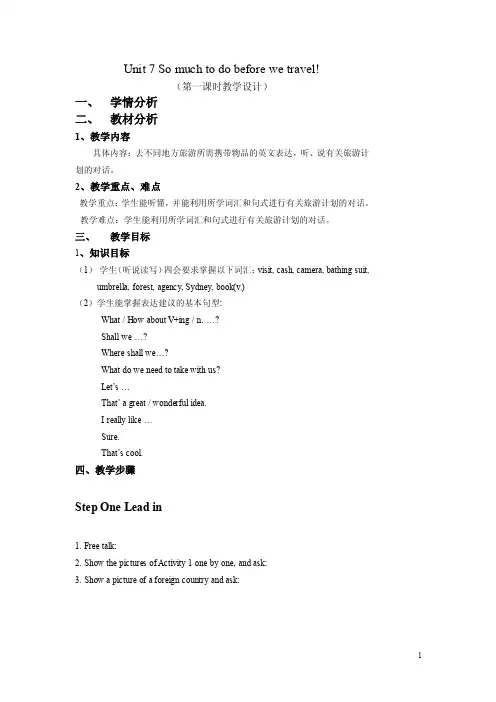
Unit 7 So much to do before we travel!(第一课时教学设计)一、学情分析二、教材分析1、教学内容具体内容:去不同地方旅游所需携带物品的英文表达,听、说有关旅游计划的对话。
2、教学重点、难点教学重点:学生能听懂,并能利用所学词汇和句式进行有关旅游计划的对话。
教学难点:学生能利用所学词汇和句式进行有关旅游计划的对话。
三、教学目标1、知识目标(1)学生(听说读写)四会要求掌握以下词汇:visit, cash, camera, bathing suit, umbrella, forest, agency, Sydney, book(v.)(2)学生能掌握表达建议的基本句型:What / How about V+ing / n. …?Shall we …?Where shall we…?What do we need to take with us?Let’s …That’ a great / wonderful idea.I really like …Sure.That’s cool.四、教学步骤Step One Lead in1. Free talk:2. Show the pictures of Activity 1 one by one, and ask:3. Show a picture of a foreign country and ask:Step Two Listening1. Read the question to the class: “What are Cindy and Annie talking about?”Ss listen and answer. (Activity 3)2. Make sure Ss understand the meanings of the words and phrases first, and then let Ss listen and tick. Check the answers. (Activity 4)Step Three Speaking1. Ask Ss to read aloud after the tape and underline the words and sentences for giving suggestions. (Activity 6)Step Four SummaryAsk Ss to review the words and phrases they have learned in class, and then summarize the sentence structures of giving suggestions. Read them together. Step Five Homework1. Ask Ss to recite the dialogue of listening after class.2. Ask Ss to copy the new words and phrases of this part.3. Ask Ss to get some information about Sydney.Unit 7 So much to do before we travel!(第二课时教学设计)一、教材分析1、教学内容具体内容:一篇有关在澳大利亚悉尼的旅游介绍,训练学生从中获取细节信息的能力。
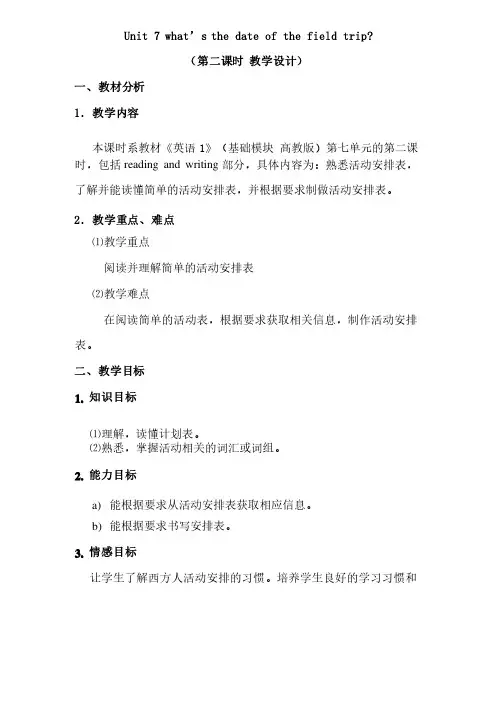
Unit 7 Unit 7 what’s what’s what’s the date of the field trip? the date of the field trip?(第二课时教学设计)一、教材分析1.教学内容本课时系教材《英语1》(基础模块高教版)第七单元的第二课时,包括reading and writing 部分,具体内容为:熟悉活动安排表,了解并能读懂简单的活动安排表,并根据要求制做活动安排表。
2.教学重点、难点⑴教学重点阅读并理解简单的活动安排表⑵教学难点在阅读简单的活动表,根据要求获取相关信息,制作活动安排表。
二、教学目标1.知识目标⑴理解,读懂计划表。
⑵熟悉,掌握活动相关的词汇或词组。
2.能力目标a)能根据要求从活动安排表获取相应信息。
b)能根据要求书写安排表。
3.情感目标让学生了解西方人活动安排的习惯。
培养学生良好的学习习惯和生活习惯。
生活习惯。
三、教学步骤Step 1 Lead-in1.Revise the words they learnt in the previous period. The teachercan use the games mentioned in the previous period.(设计意图:通过游戏,比赛让学生在轻松的氛围中回忆所学知识,为后面熟练准确的运用做好准备。
)2.Activity 10. Look and write. Students look at the pictures inactivity 10 and discuss them with the students using the following questions:1)What can you see in the pictures?2)Who are they do you think?3)What are they doing?Have the students work individually and match the phrases withthe pictures. Have a check with the students as a whole.Explain the usage of “meet”1)to wait for somebody to arrive; 接某人接某人e.g. I will meet my friend at the railway station.2)to see or know somebody for the first time; to be introduced tosomebodye. g. I want you to meet my friend, Jack.Nice to meet you.Explain the relationship between “meet”and “meeting”(设计意图:引出活动类的词汇,将学生带入即将设定的语境里,有利于后面活动的展开。
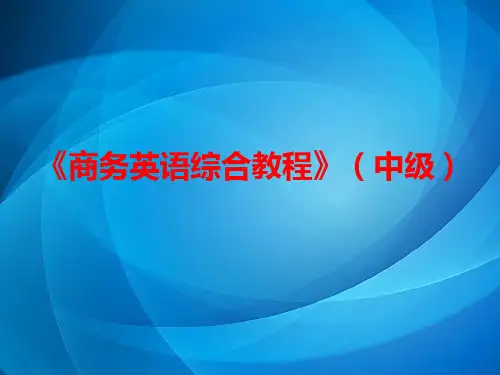
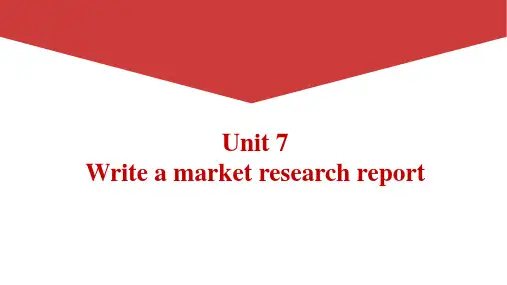

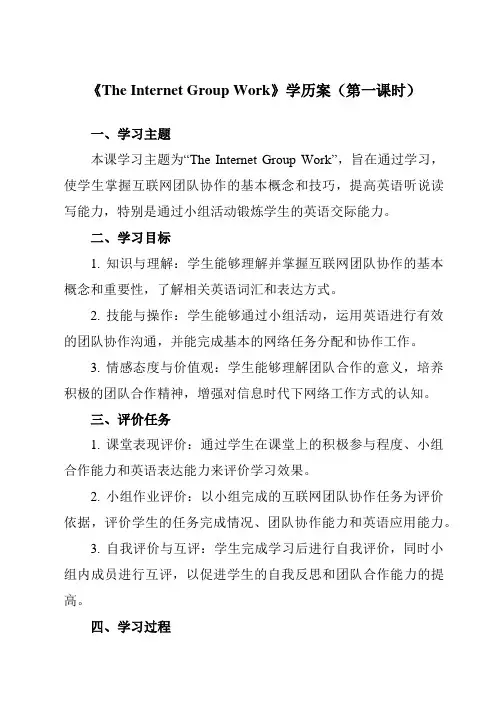
《The Internet Group Work》学历案(第一课时)一、学习主题本课学习主题为“The Internet Group Work”,旨在通过学习,使学生掌握互联网团队协作的基本概念和技巧,提高英语听说读写能力,特别是通过小组活动锻炼学生的英语交际能力。
二、学习目标1. 知识与理解:学生能够理解并掌握互联网团队协作的基本概念和重要性,了解相关英语词汇和表达方式。
2. 技能与操作:学生能够通过小组活动,运用英语进行有效的团队协作沟通,并能完成基本的网络任务分配和协作工作。
3. 情感态度与价值观:学生能够理解团队合作的意义,培养积极的团队合作精神,增强对信息时代下网络工作方式的认知。
三、评价任务1. 课堂表现评价:通过学生在课堂上的积极参与程度、小组合作能力和英语表达能力来评价学习效果。
2. 小组作业评价:以小组完成的互联网团队协作任务为评价依据,评价学生的任务完成情况、团队协作能力和英语应用能力。
3. 自我评价与互评:学生完成学习后进行自我评价,同时小组内成员进行互评,以促进学生的自我反思和团队合作能力的提高。
四、学习过程1. 导入新课:通过介绍互联网时代的背景和团队协作的重要性,引出本课主题《The Internet Group Work》。
2. 词汇学习:学习与互联网团队协作相关的英语词汇和表达方式,如“teamwork”、“collaboration”、“task allocation”等。
3. 听力训练:通过听力材料,让学生了解互联网团队协作的实际情况和基本沟通技巧。
4. 口语实践:组织学生进行小组活动,运用英语进行团队协作沟通,分配任务和协作完成一项简单的网络工作。
5. 阅读理解:阅读相关文章,加深对互联网团队协作的理解和认识。
6. 写作练习:写一篇关于互联网团队协作的短文,锻炼学生的英语写作能力。
五、检测与作业1. 课堂小测验:进行一次简单的英语词汇和表达方式的测试,检验学生的学习效果。
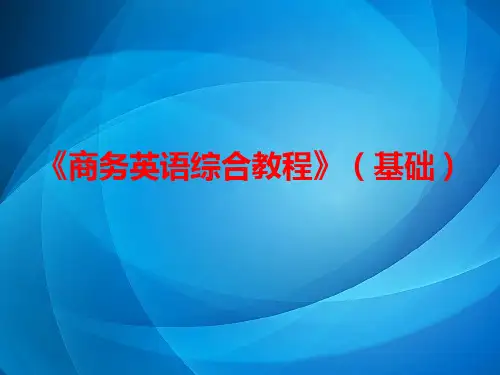
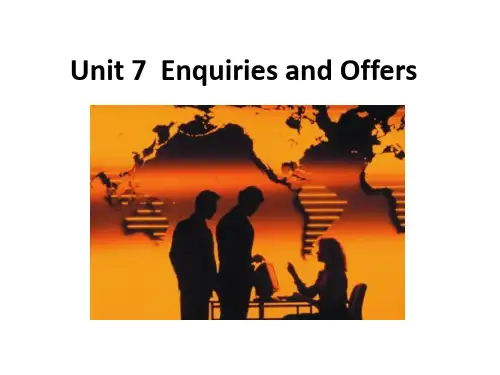
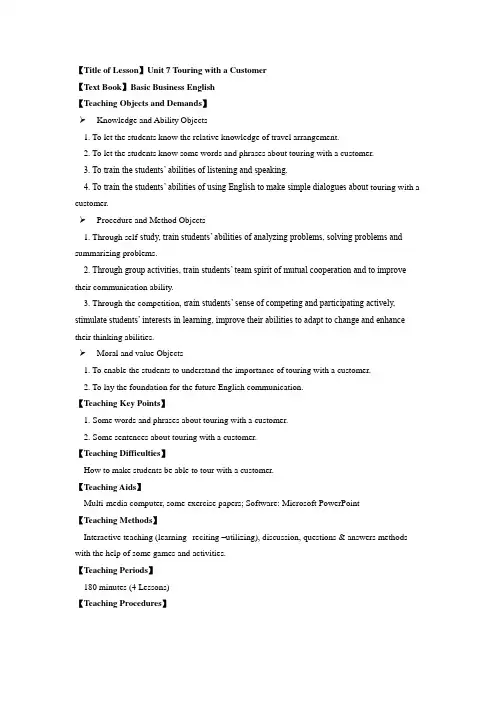
【Title of Lesson】Unit 7 Touring with a Customer【Text Book】Basic Business English【Teaching Objects and Demands】➢Knowledge and Ability Objects1. To let the students know the relative knowledge of travel arrangement.2. To let the students know some words and phrases about touring with a customer.3. To train the students’ abilities of listening and speaking.4. To train the students’ abilities of using English to make simple dialogues about touring with a customer.➢Procedure and Method Objects1. Through self-study, train students’ abilities of analyzing problems, solving problems and summarizing problems.2. Through group activities, train students’ team spirit of mutual cooperation and to improve their communication ability.3. Through the competition, t rain students’ sense of competing and participating actively, stimulate students’ interests in learning, improve their abilities to adapt to change and enhance their thinking abilities.➢Moral and value Objects1. To enable the students to understand the importance of touring with a customer.2. To lay the foundation for the future English communication.【Teaching Key Points】1. Some words and phrases about touring with a customer.2. Some sentences about touring with a customer.【Teaching Difficulties】How to make students be able to tour with a customer.【Teaching Aids】Multi-media computer, some exercise papers; Software: Microsoft PowerPoint【Teaching Methods】Interactive teaching (learning--reciting –utilizing), discussion, questions & answers methods with the help of some games and activities.【Teaching Periods】180 minutes (4 Lessons)【Teaching Procedures】Step 1: Lead-in1. Through asking the students to make a choice to lead in new lesson.T (Teacher): In last lesson, we met a foreign customer at the airport. After we conclude the business with the customer, which an arrangement will be better, to book a return ticket for him or make travel arrangements for him?Ss (Students): Make travel arrangements for himT: Yes, that’s right. When foreign customers go to a new place to do business, they must be unwilling to miss the chance to visit the famous places. So it’s better to recommend some good places to them when the sellers make an arrangement for them. Through touring with the customers, the business relations and the friendship between two parties will be further and better established. This is also an important way to do business with the others. Then how to do it? Today we will learn about it.Step 2: Listening and speaking【Teacher’s words】There are many famous places in Beijing. Do you know...?Now here is a dialogue between Mr. Hill and Miss Tang. After concluding the business, Miss Tang invites Mr. Hill from the USA to visit the Great Wall. Please listen carefully how Miss Tang tours with a customer.1. Listening ActivityA. Asking the students to listen to the dialogue carefully and repeat the five sentences together.B. Listen to the dialogue again and do Task two: Filling the missing words. Then ask two students to say their answers out. One acts as Mr. Hill and another acts as Miss Tang.C. Divide the class into several groups. Listen to the dialogue last time and discuss the questions in Task three in groups. Each group sends one student to say their answers. Then the teacher checks the students’ answers and shows out the correct answers on PPT.Aim: Through Listening Activity repeatedly to let Ss be active in thinking and train their abilities of listening and cooperation.2. Speaking Activity【Teacher’s words】Now we have learned some words and patterns about how to tour with a customer. Next we will do pair works according to the following situations:PPT shows the situations and some useful knowledge:Situation:Mr. Hanna is invited to visit a company in Dalian. After the business talk, the manager recommends Dalian coast to Mr. Hanna.The following may be useful:Have you ever traveled the city?I suggest…I can always be your guide.If you like, I can show you …I want to take a look at …What time shall we start?…A:Ask the Ss to make a dialogue according to the information within 5 minutes.B: Invite some Ss to play their dialogues in the class.Aim:Through the Speaking Activity to train Ss’ skills of listening and speaking and abilities of using language.Step3. Business Reading1. Learning the text【Teacher’s words】Just now all of you have done a good job. We now know how to tour with a customer. In fact, to have a good time in touring, it is very important to make a good travel arrangement in advance. So we’d like to learn some correct ways of making a travel arrangement. This step we will do self-study activity, Choosing Game (选一选游戏), Filling Game(填一填游戏),and Translation:(1) Self-studying ActivityA. Give Ss 5 Mins to self-study the text with two Pre-reading Questions:1. What should you first take into consideration before making the reservation?2. What should you further confirm after working out a tentative itinerary?B. Ask Ss to answer the questions.C. Let Ss explain the main meaning of the text.D. Teacher checks.E. Ss read the text together.(2)Choosing GameA. PPT shows four sentences about the text.B. Ask Ss to choose “True or False” one by one.C. Teacher checks.(3)Filling GameA. PPT shows eight sentences with one blank each. Ask Ss to fill the words in the blanks of thesentences.B. Teacher checks.C. Ss read the completed sentences together.(4)TranslationA: PPT shows five sentences from the text, ask the students to translate them into Chinese.B: Teacher checks.Aim:Through Self-Study Activity and some Games to let Ss know the meaning of text about travel arrangements, master some useful words, phrases and sentences. And by reading the text to train the students’ reading abilities and let Ss pay attention to their pronunciations.2. Games for Grammar【Teacher’s words】: In this step we will have a competition. There are nine numbers in the screen. Each number stands for one question. Divide the students into four groups, ask them to pick out one number and then answer the corresponding questions.(1)CompetitionA. PPT shows nine numbersB. Each group chooses one number and answer the question.Aim: This step of Games for Grammar is to let Ss study and review grammar knowledge about verbs happily and unconsciously, to train the Ss’ bei ng active in thinking questions and finding the answers for the questions, and their abilities of the cooperation, to enhance their skills of speaking and translating.Step 4: Consolidation and Summary【Teacher’s words】: In this step we will do many practices activities to consolidate and sum something we learn in this lesson.(1)Let Ss do the exercises “Translat ion”, “Cloze” And “Writing” to expand Ss knowledge of touring with a customer..Aim: Through many exercises to do summary and consolidation to this lesson, the Ss can review and master the knowledge which we learn in this lesson. And the teacher emphasizes the key points and difficult points of this lesson again so as to let Ss know the importance of touring with a customer.Step 5: Homework【Teacher’s words】: Here there are four home works. Each student must do the first, second and third. And Ss have the right to decide whether they will do or not do the fourth one by themselves.1. Read and recite the new words and expressions.2. Read the text fluently.3. Act as roles to make dialogues with your partners.4. Search more knowledge about touring with a customer.Aim: Through assignment by levels to let Ss choose their home works by themselves to encourage Ss to analyze themselves, improve Ss’ abilities of listening, speaking and reading further and train Ss’ abilities of communicating with others.。
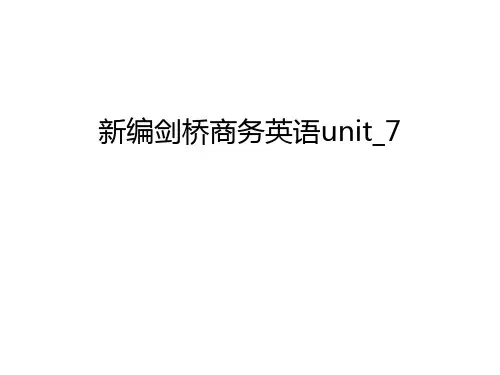
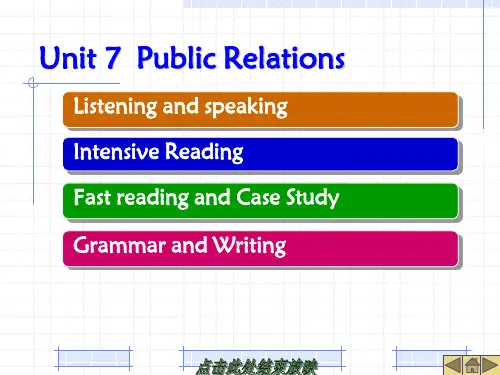
(章节教案首页)课题:Unit7 What to wear to work.(1)授课时间:年月日教学时数:( 2 )学时,其中理论( 2 )、实验( 0 )学时、上机( 0 )学时、其它( 0 )学时,其它是指:教学目标与要求:情感目标:通过学习本节课,让学生们提前了解并掌握面试礼仪知识,提高学生整体素质,增强个人修养,为今后求职成功打下基础。
知识目标:听懂并理解不同口音的英语口语;学会面试时该穿的衣服。
技能目标:能够根据不同的口音掌握文章大意;根据面试的岗位性质选择适合穿着的衣服。
教学方法设计:任务型教学法,讨论法,直观演示法,练习法教学重点与难点:教学重点:听懂并理解不同口音的英语口语;学会面试时该穿的衣服。
教学难点:能够根据不同的口音掌握文章大意;根据面试的岗位性质选择适合穿着的衣服。
主要参考资料:施志渝,《视听说教程2》,上海外语教育出版社,2020年2月.教具使用:多媒体设备,畅课平台课后作业:1.完成畅课平台的作业;2.小组合作完成110页的group work;3.预习下节课内容。
教学反思:1.整个过程应该从易到难,循序渐进,教师对整个过程要做好监督和检查的工作,帮助学生用心听,及时校正和修补听力中出现的错误和遗漏。
2.教师在介绍东西方文化差异的同时,鼓励学生广泛阅读,通过阅读,不仅可以使学生在阅读的过程中增加扩充自身的单词量,而且可以从多方面的读物内容中体会和感受不同的文化背景之间的差异,积累多方面额知识,以达到熟悉并准确理解听力材料的目的。
★Part Ⅰ导入新课1.考勤:利用畅课进行学生考勤,生成今日数据;2.以小组为单位展示作业group work,先组内点评,然后小组互评,最后教师做总结。
3.给学生们展示一段视频《当代大学生自制大学生礼仪情景剧(面试礼仪)》,以此视频引导学生们展开讨论,视频中哪些是错误示范,哪些是正确示范。
★Part II 讲解新课教师发布任务:Task 1In this part you will hear four speakers talking about their travel with different accents. Listen carefully and fill in the missing words.Speaker 1Before going on a trip I pay the bills, I empty the trash, and I give a house key to a friend.Speaker 2Before I leave on a trip, I turn off the lights, I turn off my heater , I give my keys to my roommate, and I water my plant .Speaker 3The funniest story of my traveling experience was when I came to the U.S.for the first time by myself. They lost my luggage and I didn’t speak a word of English. I had to use my hands to explain myself. People understood what I meant and they helped me out.Speaker 4My recent trip to Africa was one of the most amazing trips of my life. This was my second trip to Tanzania, Africa . We visited a lot of villages, some so remote that we had totravel by he licopter. In Tanzania, it’s very dif ferent from America and there are no maps . So, even traveling in a helicopter, we didn’t really know where we were going to go.Task 2Learn new words and expressions:aerobics n.Tai Chiunwind v.bottom of the league学习新单词和词组,教师用听写,单词字母接龙,或者随机点人点单词的方式检测学习效果。
Unit 7 (a) Product descriptionI. Teaching Objectives:i. To enable Ss to describe products in general termsii. To practise listening for specific informationiii.To review language for talking about dimensions and comparatives and superlativesiv. To practise question formationII. Materials needed: Cassette-Pass cambridge BEC PreliminaryIII. Teaching Process:i.Unit overview·Presenting a productWarmer: T elicits vocabulary related to board game.Listening 1: Ss listen to a presentation of new board games and identify pictures. Ss listen for more detail and identify what notes referto. T reviews language related to dimensions.Language focus: Ss form questions about the games.Speaking: Ss work in pairs and describe a board game they like. ·Describing a productListening 2: Ss listen to the same sales manager talking to a retailer and identify which games are of interest. Ss then listen again andanswer compprehension questions.Langues focus: Ss review comparatives and superlatives.Speaking: Ss work in pairs. They list and rank points they considered when buying something they both bought.·Self-studyV ocabulary: Word-building and question formation exercise.Language focus: Comparatives and superlatives exercise.Writing: Ss write about a product they have recently bought.Exam pppractice: Multiple-choice gap-fill.ii.Detailed study of this unitStep 1 Presenting a productWarmer: T writes board game on the board. T asks Ss to work I pairs and think of five words or phrases connected with the idea of board game. T elicits Ss’responses and uses this as a chance to pre-teach necessary vocabulary for the unit, i.e. board, dice, timer, cards, pieces and counters.Ex.1 ListeningRobert Saunders, the Sales Manager at Columbine Games, talks about two newproducts. Ss listen and identify the two games which Robert describes.Notes :1. Mind twist 脑筋急转弯2. our latest products in our range of games 游戏玩具系列中的最新产品3. Which comes in two versions 现有两种版本供应Come: 被出售,被供应4. the four playing pieces are magnetic counters which are made of colored plastic 四个带磁的圆形硬片是用彩色塑料做成的(counter筹码)Ex.2 Listening 1Ss listen to the cassette in more detail and decide what the numbered descriptions refer to.Key:Note:1. How big is / What is the size of…2. How heavy / What is the weight of…3. How much / What is the price of…Ex.3 GrammarT elicits complete questions for the first few answers in Ex.2. T asks Ss to work in pirs and form the remaining questions. Ss are expected to demonstrate their ability to form questions in Part 2 of the Speaking Test.Ex.4 SpeakingSs work in pairs describing games that they like. In order to give this activity more structure and review language which has arisen during the lesson, T writes some prompts on the board , e.g., type of game , size, weight, material, price, how to play, comments.Useful expressions:1.bigger / smaller than…2.It measures 50×50cm3.It weighs…4.light-weight 轻质的5.The weight of it is…6.lighter and smaller…7.wooden playing pieces…木质的棋子8.be made of …9.It only costs…10.To retail at…11.The retail price is …12.easy to play…13.This is a game for 3 or 6 players.14.The material of playing pieces is …Step 2 Describing a productBefore Ss listen to the cassette, T prepares them by asking how they think Columbine sells its games: directly to the public? Through catalogues? Through retailers? Etc.Ex.1 Listening 2Ss listen for gist on the first listening, simply to get an idea of the games Sophine is interested in.Note:1. collectables 收藏品2 .The recommended retail price 建议零售价3 .And what would you be willing to sell it to us for ?= And what price would you be willing to sell it to us?4. on large orders: 大宗定单5. Not on Mind twist on its own.只买脑筋急转弯不打折Ex.2 Listening 2Then Ss listen the same cassette again and answer more detailed questions. Ex.3 GrammarT asks Ss to correct the sentences about Columbine’s games. As students focus on correctness of meaning, they will be using the comparative and superlative forms referred to earlier. T may point out that fewer in the first sentence is used with countable nouns. Less is only used with uncountable nouns.Ex.4 SpeakingSs works in pairs and think of something they have both bought. They discuss the criteria they used in selecting it and write them down. They then order all of the criteria mentioned in terms of importance for themselves. T gives them a little more time to prepare to report back to the rest of the class.Useful expressions:1.reliability2.image3.performance4.energy-saving5.to save petrol ASAP6.I prefer to choose the leading brands with reasonable price.7.I’m more interested in the image of car.8.I think about after-sales service.9.I pay much attention to the reliability on the past of the sellers.10.Safety system is as important as energy-saving system.Step 3 Self-studyHelp Ss finish exercises in this part.Ex 4 Exam practiceNotes:1.the latest addition to our extensive 最新产品2.flexible machine 多功能机器3.variety 种类,强调与众不同4. range (在某一范围内)同类货品,一批,系列5.spread 差异,差距6.provide sb. With sth. / provide sth.7.however :然而,可是,要用逗号与其他成份分开Unit 7 (b) Product developmentsI. Teaching Objectives:i. To enable Ss to talk about product developmentii. To practise reading and listening for specific informationiii.To review specific words ( first, after that etc.)iv. To review the present continuous and going to for future arrangements and intentionsII. Materials needed: Cassette-Pass cambridge BEC PreliminaryCards- Set A 9 cards: one set of cards per pair/ group to bephotocopied from T’s GuideIII. Teaching Process:i.Unit overview·Product testingSpeaking: Ss do a quiz about drug development in the USA.Reading: Ss read an article to find answers to the quiz. Ss re-read the article and complete a table aboout the stagesof the development process.Language focus: Ss review language for sequescing ( first, then, nest etc.) Writing: Ss put cards describing the drug development process in order then write a text linkin the stages.Speaking: Ss talk in pairs about the development of one of their company’s products or services.·Making a productListening: Ss listen to a marketing manager talking about plans for the launch of a new arthritis drug and answer comprehensionquestions. Ss listen again and order the stages in the process.Langues focus: Ss review the present continuous for future arrangements and going to for intentions.Speaking: Ss talk in pairs about their company’s plans. Ss then ask and answer questions about personal plans.·Self-studyV ocabulary: Gap-fill exercise.Language focus: Gap-fill exercise.V ocabulary: Multiple-choice gap-fill exercise.Exam pppractice: Multiple-choice comprehension exercise.ii.Detailed study of this unitStep 1 Product testingWarmer: T writes drug development on the boardand asks Ss to work in pairsand think of five words connected with the subject (test, monitor, launch, develop, animals)Ex.1 SpeakingSs work in pairs and do a quiz about drug development. The aim is to interest Ss in the topic and to provide a reason for reading the article in Ex. 2.Ex.2 ReadingSs read the article to find the answers to the quiz.Notes:(1) be to + 不定式结构表示的将来动作一般都是受人们一直控制的,表示计划,安排或受人之示,be going to 表示现在的意图。